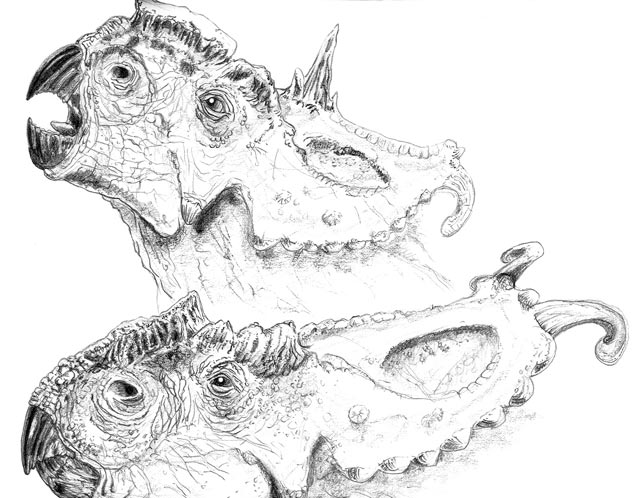Huge Pachyrhinosaurus Dinosaur Skull Discovered in Alberta
Many different types of horned dinosaur are known from Upper Cretaceous deposits of Canada and the United States, one of the best represented of all the ceratopsian genera in Canada is Pachyrhinosaurus, a member of the centrosaurine group.
Fossil Discoveries
Despite a lot of fossil discoveries over the last seventy years or so, finding cranial fossil material from a pachyrhinosaur is still a significant event. A team of researchers from the University of Calgary have reported finding an enormous skull of an old, mature Pachyrhinosaurus, this fossil material might represent the largest skull specimen of a Pachyrhinosaurus discovered to date.
The specimen was found back in October 2013, close to the town of Drumheller, a part of Alberta, that team members at Everything Dinosaur know very well. Assistant Professor Darla Zelenitsky, a leading vertebrate palaeontologist, was conducting a routine survey of one of the very many fossil deposits in the area when the discovery was made. What at first glance looked like an outcrop of rock, was actually the partially exposed remains of a dinosaur’s skull. The skull is believed to measure around two metres in length.
Commenting on the importance of the University’s fossil find, Assistant Professor Zelenitsky stated:
“Based on our preliminary estimates, the dinosaur’s head would have been well over two metres long and was likely of a mature or older individual. The skull of this animal has an enormous bony structure over the snout that would have made for a very strange looking individual.”
The Assistant Professor from the University’s department of Geosciences went on to add:
“It is very rare to find such a complete skull specimen of this size and type in the region.”
Three Species Recognised
Currently, three species of pachyrhinosaur have been assigned to the Pachyrhinosaurus genus, at this stage Everything Dinosaur team members have proposed that as this material comes from the famous Horseshoe Canyon Formation, it is likely to represent a Pachyrhinosaurus canadensis, although if the fossil material is from a older component of this formation it could be a skull from the species which was described in 2008 and known as Pachyrhinosaurus lakustai.
The pachyrhinosaurs were one of the last of the great horned dinosaurs to evolve, P. canadensis for example, is known from fossil bearing strata that has been dated to around seventy million years ago. Growing to lengths in excess of six metres and perhaps weighing as much as three tonnes, these herbivores were sizeable dinosaurs.
Palaeontologist Darla Zelenitsky with the Newly Discovered Pachyrhinosaur Fossil Material
Picture credit: University of Calgary
Pachyrhinosaurus
The picture shows Darla with part of the skull exposed and the remainder still sitting in its jacket of burlap. Behind the fossil is an illustration of a Pachyrhinosaurus (artwork by Julius Csotonyi). After the initial discovery, the research team with the help of a number of field staff removed several thousand kilogrammes of surrounding rock to extract the skull material. The skull has spent the last four months or so in a laboratory at the University being carefully prepared for study.
Explaining the preparation work that had been undertaken, Darla stated:
“So far, the upper part of the skull has been exposed and the skull will be flipped over to prepare the lower part, including the jaws. There are still many months of work necessary in order to clean the entire skull.”
It has also been suggested that this pachyrhinosaur material could represent a new species, further examination will be required before any conclusions can be drawn. Pachyrhinosaurus is already the most speciose of the centrosaurine genera and the problem with horned dinosaurs is that as these animals grew and matured, so their skull morphology and its ornamentation changed.
Combine this with any subtle distortion that may have occurred during the fossilisation process and determining a new species, even from an 85% complete skull will be no mean feat.
An Illustration of a Pair of Pachyrhinosaurs
Picture credit: Mike Fredericks
Associate Professor Zelenitsky outlined the team’s next steps:
“Our initial goal will be to determine if this specimen represents a new species. Following that, the specimen will be measured and scanned to help document how the skull of pachyrhinosaurs changed during growth, particularly in the later stages of life. A discovery of this nature will certainly add to our understanding of the biology of pachyrhinosaurs.”
Pachyrhinosaurs in the Spotlight
Pachyrhinosaurs have recently been very much in the spotlight when it comes to horned dinosaurs. A herd of pachyrhinosaurs were the stars of the recent film “Walking with Dinosaurs in 3-D” in addition, Pachyrhinosaurus was named the ninth most popular prehistoric animal in Everything Dinosaur’s annual survey of prehistoric animal popularity. Safari Ltd have recently introduced a highly acclaimed model of a Pachyrhinosaurus (believed to represent P. canadensis) into the popular Wild Safari Dinosaurs model range.
The Wild Safari Dinosaurs Pachyrhinosaurus Dinosaur Model
Picture credit: Safari Ltd
For models and replicas of horned dinosaurs and other prehistoric animals: Wild Safari Prehistoric World Replicas.
It is hoped that once the skull material has been fully prepared and cleaned it will be put on permanent display at Calgary University. The Geosciences department have plans to explore the vicinity of the skull fossil find, in case other elements from the skeleton of this dinosaur can be found.








Was the species ever determined for this skull? Anyone know what the length turned out to be?
We have asked the University for an update.